
 The 1960s represented a final flourish for the ocean liner, yet amongst the European countries proudly parading new national flagships there was a notable absentee, West Germany. Ultimately it would take a Dane of formidable energy and aptitude, to organise the first large passenger liner to be built for German owners in 30 years.
The 1960s represented a final flourish for the ocean liner, yet amongst the European countries proudly parading new national flagships there was a notable absentee, West Germany. Ultimately it would take a Dane of formidable energy and aptitude, to organise the first large passenger liner to be built for German owners in 30 years.
At the end of the Second World War the victorious Allies imposed draconian restrictions on the German Merchant Marine, including a moratorium on the building of new liners. Most of the pre-war fleet had either been sunk in the conflict, or awarded as reparations to the allied nations. Tentatively in the early 1950s, the former Goliath’s of the transatlantic scene, Hamburg America Line and North German Lloyd had entered the passenger ship business with the assistance of ‘neutral’ Swedes, but this was using chartered and second-hand vessels.
It was the aforementioned Dane, Axel Bitsch-Christensen (affectionately known as ABC) who injected impetus into rejuvenating the German marine, and in particular the historic port of Hamburg. In 1958 he introduced the rebuilt Canadian Pacific liner Empress of Scotland, as flagship of a new venture called Hamburg-Atlantik Line. Proudly bearing the name Hanseatic, she became a symbol of pride for a nation and city still recovering from the trauma of conflict. Haneseatic’s success prompted Bitsch-Christensen to plan a new liner as early as 1962. He also devised a quite unique way of financing the project, utilising the popularity and patronage of the existing ship. Both the Federal and local Hamburg authorities had pledged to support the new construction in the form of loans and guarantees, however this was conditional on the shipping company securing an additional 30 million Deutsch Marks. The solution was a share issue, costing $25,000 per share, which was taken up by 225 of Hanseatic’s most loyal, and wealthy, patrons. His proposal included the formation of a new company to finance the building and operation of the ship. Consequently, Deutsche Atlantik-Schiffahrts GmbH & Co., trading as Deutsche Atlantik Line (German Atlantic in English), was founded in Hamburg, aboard Hanseatic, on 1st December 1965.
Tenders were invited from three local yards, Blohm & Voss, Deutsche Werft and Howaldtswerke Hamburg. Initially this was for a 20,000 grt, 24 knot vessels but by mid-1966 this had been slightly increased to 22,000 grt, with a consequential increase in capacity from 485 cruise passengers to 650. ABC favoured the Blohm & Voss tender but as Government money was being used for construction, political pressure resulted in the building contract being awarded to state owned Deutsche Werft. For Bitsch-Christensen there was the compensation that design and general arrangements would be to Blohm & Voss ‘specifications. Initial artist impressions showed a ship broadly similar to Swedish America’s soon-to-be-delivered Kungsholm but with a single, boldly conventional funnel and no mainmast.
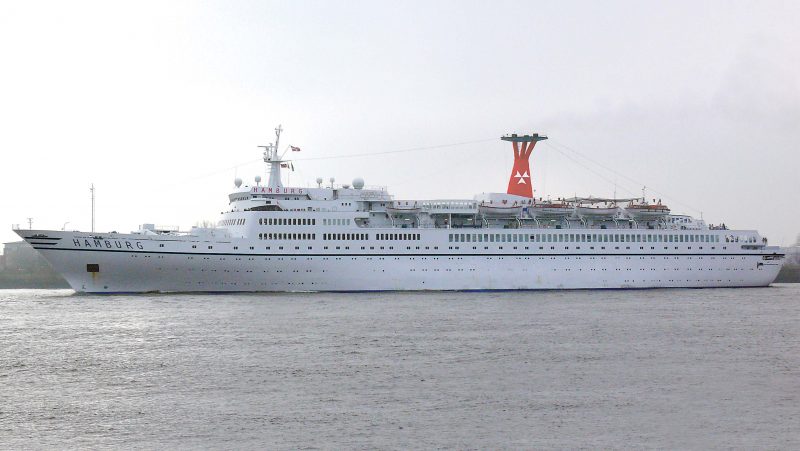
In the late summer of 1966, just prior to the formal announcement of the order, tragedy struck. On 7th September 1966, Hanseatic was berthed at New York when she became engulfed by that most feared of maritime elements, fire. Although she remained afloat the damage was too extensive, and despite being towed back to Hamburg she was declared beyond economic repair. The loss of his beloved flagship inevitably tarnished Bitsch-Christensen’s enthusiasm at signing the contract for the new liner on 10th October 1966. Just over 9 months later, on 21st July 1967, three prefabricated sections were welded together on the slipway as the first elements of yard number S825’s keel took shape. With two years before anticipated completion, German-Atlantic needed an interim vessel. Initially they chartered Paquet’s diminutive Renaissance but after formulating a similar share issue arrangement, they secured a replacement Hanseatic, in the form of Zim Line’s, virtually brand new flagship, Shalom, in November 1967. The new Hanseatic maintained just a single season of North Atlantic crossings over the summer of 1968, before the line announced its full time devotion to the burgeoning cruise trade. At around this time there were also discussions about a profit share agreement with Norddeutscher Lloyd. This would include joint marketing of the ships through the worldwide network of Hapag-Lloyd agencies, particularly the USA. Brochures were issued but German Atlantic considered their newer ships would be more attractive to prospective customers than the ageing Bremen and Europa. Within a year the agreement broke down.
Progress on the new hull was rapid and much of the superstructure had also been completed prior to launch. February 21st 1968 dawned frigid and foggy but there was a tremendous sense of excitement amongst the attendant crowds sheltering from the chill, arctic wind. Godmother to the gleaming white vessel looming over the yard was Marie Luise Kiesinger, wife of the German Chancellor. Named Hamburg she slid into the river to the cheers of spectators amassed at the yard and aligned on the opposite bank. Within a year fitting out was completed and Hamburg was ready for her sea trials. Like many contemporaries the new ship’s profile was quite unique and drew praise and criticism in equal measure. Once again the funnel was the focus of attention, resulting from exhaustive wind tunnel testing and quite a departure from the original, traditional, artist’s impression. The slim lower casing divided into three separate pipes in an inverted tripod. These pipes supported a circular 33ft diameter cap, creating what was variously described as the three fingered ash tray, an hour glass or the flying saucer. Shipyard workers, lacking either inspiration or imagination simply called it ‘the thing‘. Iconic or detested, the fact was that the funnel was both effective and symbolic of the ship.
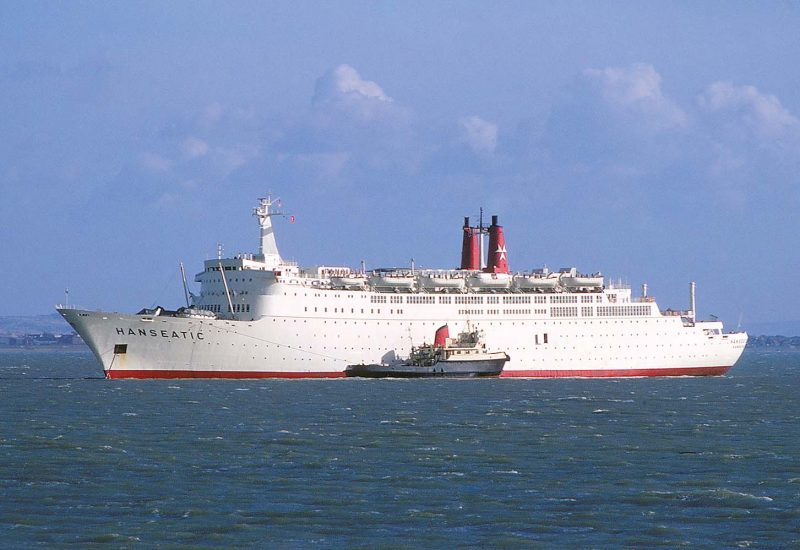
In the manner of the age, Hamburg eschewed the svelte, curvaceous symmetry of Kungsholm for a sturdier, almost masculine angularity. From the knuckled bow to the squared off forward bulkhead and bridge front Hamburg presented an image of strength. Deutsch-Atlantik invoked the sobriquet ‘The Space Ship’, to promote her position as the lowest density luxury cruise ship, on a tonnage per passenger ratio. It was a clever marketing strategy, fitting neatly with the impending moon landing in July 1969. In spite of her futuristic funnel and general profile there were some elements of her design which were very traditional. Forsaking the aluminium used in the superstructure of almost every other 1960s liner, Deutsche-Werft utilised steel throughout. Heavier but stronger, it was also substantially cheaper than the ultra-light alloy.
Three weeks ahead of schedule, sea trials were conducted in the North Sea and off the Norwegian coast. Her AEG steam turbines driving twin screws attained a maximum speed of 23.5 knots, a full 2.5 knots above her contracted service speed. Fortunately there were none of the mechanical gremlins that hampered the one other liner entering service in 1969, Cunard’s Queen Elizabeth 2. On 20th March, Hamburg left her berth with 700 guests on board and steamed down the Elbe to Cuxhaven. Unusually the official handing over ceremony between builder and owner occurred at sea and so she returned to her eponymous home port a Deutsche Atlantik ship. Indicative of the fundamental changes in passenger shipping, Hamburg’s maiden voyage was not a trans-Atlantic crossing but a 36 day odyssey to West Africa and South America. She sailed from Cuxhaven on 30th March, then repeated the itinerary in early May. Like all her cruises, these voyages were one class with passengers enjoying free run of the ship. Public rooms were primarily concentrated on Promenade and Lido decks. In common with most contemporary tonnage there was an emphasis on extending lounges the full width of the ship including the Atlantic Club, situated right forward on Lido Deck. The interior design of Hamburg was co-ordinated by Georg Manner, an eclectic mix of rich wood veneers and modern plastics, furniture and light fixtures. Fulfilling Bitsch-Christensen’s brief to create a homely ambience ‘a place you don’t get sea sick just looking around’, perhaps the greatest testimonial to Manner’s achievement was that the interiors remained broadly unchanged for four decades.
Facilities included a large central swimming pool on Lido deck open to the elements but like Kungsholm’s encircled by protective screening. There was the 290 seat Hansa Theatre, variously utilised as a cinema venue for stage productions or lectures, and a traditional library. Commonplace nowadays, her owners were also keen to offer a variety of dining options and so three separate restaurants were provided despite her one class employment. Not everyone welcomed this innovation. Two of the dining rooms including the exclusive 120 seat Grill Room were tucked down on the lowers passenger deck (Restaurant Deck) with no natural light, acceptable for a full-time liner on the inhospitable Atlantic but hardly inspiring for a tropical cruise ship on which passengers would expect sea views. Similarly counter intuitive was the preponderance of inside cabins, accounting for more than a third of all passenger accommodation. This was the result of a unique innovation, a broad six foot wide passageway running along the ship’s central line, providing the only thoroughfare on each cabin deck. The designers had concluded that the introduction of closed circuit television and one of the first bridge cams would adequately substitute for a porthole view. At the time this was seen as progress but later in the ship’s career the preponderance of inside cabins became a handicap. Nevertheless all accommodation was spacious and well appointed, the pinnacle being 20 deluxe suites.
Although the scheduled service had been abandoned the previous year, German Atlantic continued to offer irregular Atlantic crossings when repositioning between cruising grounds. So on 18th June 1969, a month after QE2’s much delayed maiden arrival, Hamburg sailed from Cuxhaven to New York via Rotterdam and Southampton. Amidst the traditional pomp and fireboat plumes, Captain Helmut Bender guided the new vessel up the Hudson to Pier 40 at the foot of Houston Street, Holland America’s modern, three berth facility. There would be none of the leisurely introductions normally associated with these occasions, Hamburg was re-provisioned and readied for re-crossing on a northerly tract, destined for the Scandinavian capitals, Norwegian fjords and the ubiquitous midnight sun. Bookings were strong and ultimately Axel Bitsch-Christensen’s vision and investment would be vindicated. Alas that success and profit would be reaped utilising his ship but by different owners. Although they secured a loyal following in their native West Germany, the epicentre of luxury cruise travel remained the United States. Long voyages from east coast parts to Scandinavia and the Mediterranean were interspersed with South American and West Coast itineraries as far as Alaska.

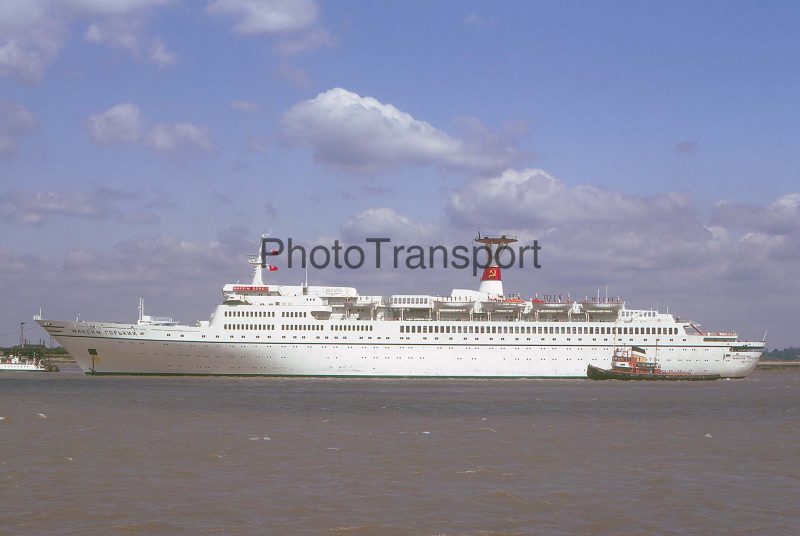
Circumstances were already mounting against them. 75% of the company’s income was derived in US dollars but the majority of expenditure was in Deutsch Marks (DM). A weak dollar was formally devalued in 1969, and already wavering on the financial ropes, Deutsche Atlantik Linie suffered successive body blows from a 70% wage increase for the already costly German crew, and the quadrupling of bunker oil prices in 1973. The DM50 million deficit was unsustainable and so Hamburg was sold in July 1973 to Home Lines, as a replacement for their recently fire-damaged Homeric. In a misjudged marketing move Hamburg was renamed Hanseatic but this backfired with passengers rebuking the company’s flagrant manipulation of a well-respected name. In fact Deutsche Amerika were already in advanced negotiations with Hapag-Lloyd about the latter’s acquisition of the ship. A month later, in October 1973, a higher bid of DM67 million was received from the Japanese shipping conglomerate Ryutse Kaiun KK. Frustratingly there were contractual problems and ultimately the sale fell through. With the next loan instalment due, DAL’s board were forced to accept a DM62 million offer from the Robin Shipping Company of Monrovia. This Liberian offshoot was, in fact, an intermediary working on behalf of the Black Sea Shipping Company, part of the Soviet Union’s state-run SOVCOM fleet.
On 25th January 1974 the erstwhile Hamburg was handed over to her new owners and renamed Maksim Gorkiy. Within a month she had adopted yet another, albeit temporary pseudonym, Britannic. Ironically and seemingly contradictory to their political ideals, the Soviets were always looking to maximise their hard currency earning, so when United Artists sought a suitable vessel for their latest blockbuster ‘Juggernaut’ (a maritime entry in the then popular disaster movie genre), the Soviets readily chartered their new acquisition. Featuring Omar Sharif, Richard Harris and Anthony Hopkins, the film provides wonderful airborne views of the former Hamburg in turbulent seas, an historical record few could have anticipated. The plot revolves around a blackmailer who threatens to detonate bombs planted on board, unless his demands are met. Fact and fiction would subsequently become blurred in November 1975, when two bombs were planted on board Maksim Gorkiy at St. Juan, exploding near the waterline as the ship approached New York. The culprits were never identified but the ship suffered only minor damage, which was repaired at the Bethlehem Steel Company.
At this time the Soviet Union had the largest fleet of passenger ships in the world. They still maintained a transatlantic service but the majority of former liners were now employed in the increasingly lucrative charter cruise market. Maksim Gorkiy was certainly their most luxurious vessel. After her brush with Hollywood Stardom Maksim Gorkiy was chartered to US operators for the balance of 1974 and into 1975, primarily providing cruises to the Caribbean from New York. Whilst America remained the epicentre of this evolving industry, cruising was becoming increasingly popular in Europe, including West Germany. The evident success of Hapag Lloyd’s Europa prompted interest from other tour operators, amongst them a company known as Neckerman Seereisen. Axel Bitsche Christensen’s goal had been achieved and over the next decade his beloved, the former Hamburg, became a fixture of the German cruising scene, on European and worldwide itineraries. Her name Maksim Gorkiy in prominent Cyrillic lettering on the bow, the hammer and sickle bracketing the red band on her funnel, and her Russian crew betrayed her Soviet ownership but this did not dissuade her well-heeled West German clientele. Indeed, politics only intervened once in the course of this charter, in 1980 she was refused entry to New York by the US authorities, as a sanction against the Soviet invasion of Afghanistan.
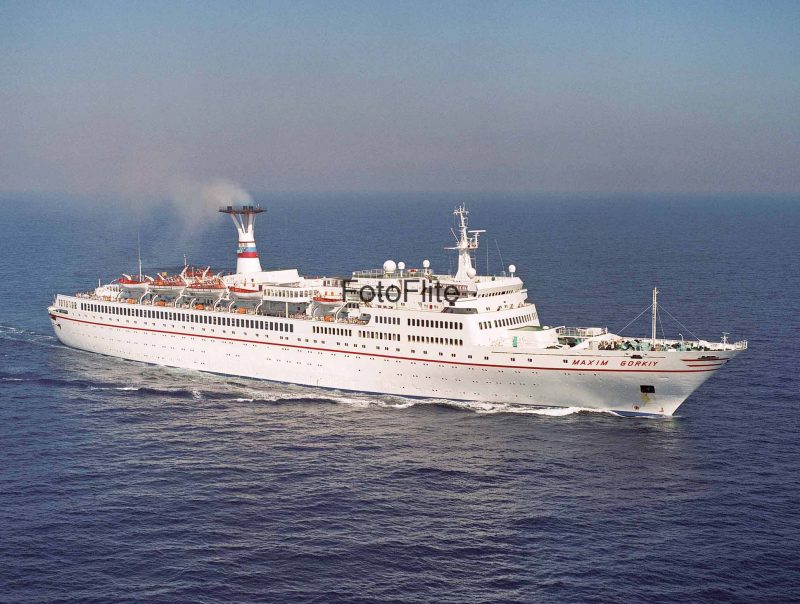
By 1988, charter rates had increased substantially, Neckermann Seereisen decided not to renew their contract and returned Maksim Gorkiy to her owners. Nevertheless the ship had developed an excellent reputation, she was still fondly remembered from her German-Atlantic days and there was clearly a market to be harnessed. Stepping into the void was yet another newcomer to the cruise industry, the package holiday company Phoenix Reisen GmbH. They took the ship on a 3 year charter and after a comprehensive refit which included the installation of a bow thruster, she departed Hamburg on 23rd December 1988, for her first cruise. Phoenix Reisen would end up operating the ship for two decades under charter and subsequently ownership, however it could have been very different. In June 1989, Maksim Gorkiy sailed north to Iceland on a classic ‘midnight sun’ cruise. On 19th June she was skirting the coast of Spitzbergen when ice was sighted. Despite the evident threat, Captain Galimow maintained her 18 knot cruising speed, and it was an almost fatal error of judgement. In the evening twilight Maksim Gorkiy struck ice which pierced her hull. Arctic water gushed into the stricken forward compartments, through two holes 7 and 20 feet wide respectively, more than the ship’s pumps could cope with. As she started to settle by the bow and develop a pronounced starboard list, frightened passengers, who had been called to their muster stations, were shepherded aboard the lifeboats. Fearing that the list would prevent their later launch, the port side boats were filled and lowered into the calm waters. The superficially benign conditions hid a further threat however, surrounding pack ice drew in around the stricken cruise ship but the most imminent danger was to the flotilla of lifeboats and their freezing incumbents. Fearing the boats might be crushed, reports suggested some passengers scrambled onto an adjacent ice floe. Disaster was averted thanks to the intervention of the Norwegian coastguard ship Seija, which hurried to the scene through 3 miles of pack ice which was up to 2.5 metres thick, rescuing the passengers who were then taken to Longyearbyen, for onward flights home. Seija also provided additional pumps, eventually righting the stricken cruise ship, whose bow had been submerged down to main deck. After temporary patching at Spitzbergen, Maksim Gorkiy steamed south for a 6 week refit, to effect permanent repairs and refurbishment/restoration of the flooded areas at Lloyd Werft’s Bremerhaven yard.
Six months after hitting the headlines for her ice encounter Maksim Gorkiy was in the news again. Although inclement weather once again intervened, this time the Maksim Gorkiy became the unlikely saviour. 1989 was a year of monumental change, the Soviet leader Mikail Gorbachev’s policy of Glasnost (‘openness’ in English) created optimism and ultimately the erosion of totalitarian regimes across Eastern Europe. Nowhere was this dramatic transformation more vividly symbolised than with the dismantling of the Berlin Wall in November and the emotional reunion of the German state. In December a summit had been hastily arranged between Gorbachev and President George H. W. Bush aboard the American warship USS Belknap, stationed off the Maltese coast. The Mediterranean in mid-winter can be a tempestuous place, far removed from its placid summer reputation. With storms lashing the Belknap, the globe’s two most powerful leaders were forced to look for an alternative venue. Coincidentally, Maksim Gorkiy was at Valetta on 3rd December 1989 and was hastily transformed from leisurely cruise ship, into superpower conference venue.
The subsequent collapse of the Soviet Union led to the dispersal of the Black Sea Shipping Company fleet amongst the newly independent republics. The hammer and sickle disappeared from the funnels of these former fleet mates to be replaced by national colours. For Maxim Gorkiy (the name, now written in Latin lettering on the bow, had an anglicised spelling) this meant the white, blue and red bands of Russia as the last vestiges of the Soviet era appeared to have been fully erased. In fact, one symbol remained throughout the rest of her career, the red five pointed star that had replaced the Hamburg crest on the ship’s prow was retained, less one suspects for nostalgia, than for simple ease of maintenance. There were no more dramas, nothing to trouble the media in the following two decades. With the exception of the lower deck restaurants, which had been virtually rebuilt following her Spitzbergen escapade, her interiors remained broadly unchanged. Comfortable and cosy, the original fittings became a hallmark of the ship as she aged graciously, beloved by passengers and crew. Although her owners changed several times over the rest of her career, one constant was Phoenix Reisen’s charter. From 1996 she adopted the company’s corporate funnel design of white albatross and yellow sun upon a turquoise background.
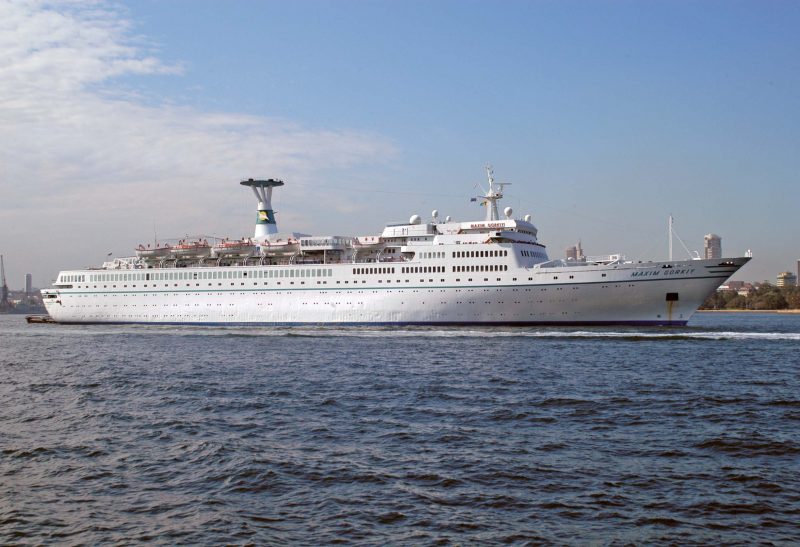
Like near contemporaries, Saga Rose, Oceanic and QE2, Maxim Gorkiy was starting to show her age towards the end of the first decade of the new millennium. Despite her loyal following, passenger expectations were changing, with balcony cabins and a range of leisure facilities now a prerequisite. Fuel, crewing and maintenance costs were disproportionately high, so Phoenix Reisen decided to invest in newer, second-hand tonnage. When the charter period came to its conclusion in the autumn of 2008, Maxim Gorkiy was returned to her owner.
In early 1990s entrepreneur Gerry Herrod had created a new cruise line, Orient Lines. He had purchased the redundant Soviet liner Alexander Pushkin and transformed her into the destination cruise ship Marco Polo. In August 2008, with an odd sense of déjà vu, entrepreneur Wayne Heller announced plans to revive the brand, utilising Maxim Gorkiy, which would be renamed Marco Polo II. Publicity material showed the ship looking resplendent in the Orient Line colours, including a deep blue hull. A maiden voyage was scheduled for April 2009. Unfortunately, despite the best intentions, the plans were quietly shelved in November 2008, as the world spiralled thorough economic turmoil. Optimistically, in December 2008 there was talk of a static role in Hamburg, as a hotel, museum and convention centre. The city authorities were said to be supportive of the plans but ultimately this too remained little more than a pipe dream.
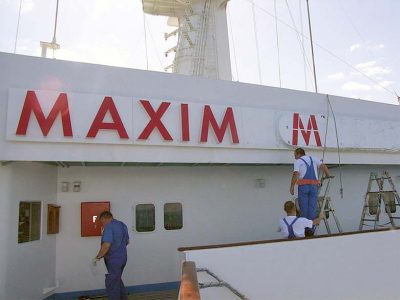
A month later rumours were confirmed, the ship had been sold to Indian scrap merchants and she departed Piraeus as Maxim M, on a final voyage East, via the Suez Canal. By late February the Maxim M was off the Gujarat coast and on 25th February her turbines were fired for one final time as she was driven onto the gently shelving, toxic sands of Alang. Months later she was gone, the end of one of the most beloved German passenger ships of all time.

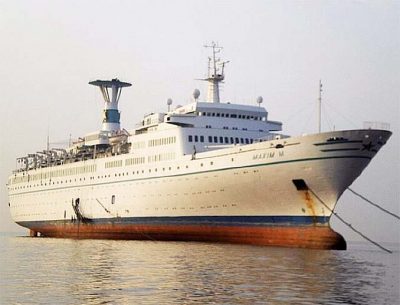
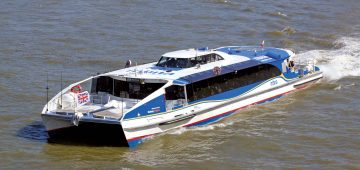



Comments
Sorry, comments are closed for this item